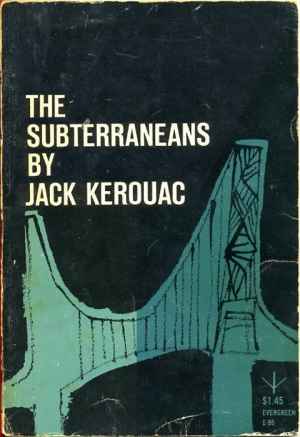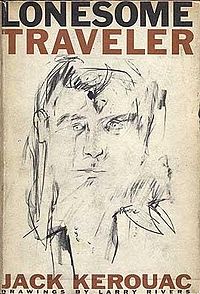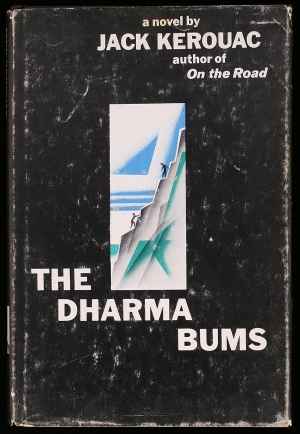Beyond ‘On The Road’: 3 More Jack Kerouac Books You May Like
Jack Kerouac’s On the Road is the bible of the Beat Generation and his most well known novel. Jazz, drugs, sex and hitchhiking fill its pages and immerse the reader in 1950s America. The novel is based on Kerouac’s own travels across the U.S.A with the story following Sal Paradise (Kerouac himself) and his friend Dean Moriarty (Neal Cassady) as they criss-cross from New York in the East to San Francisco in the West.
Not only does the novel faithfully capture that time in it’s characters and locations, but also in Kerouac’s writing. On the Road is the first example of ‘Spontaneous Prose’, the phrase coined by Kerouac to describe his writing style. This approach is about trying to capture events and speech as they happened. Paragraphs are long without many stoppages – Kerouac preferring to use connecting dashes. Sentences often seem improvisational, like the Jazz music of the time, creating a sense of poetic rhythm. It is the undisturbed flow of a person’s thoughts set down on the page.
Walter Salles’ recent film adaption of On the Road highlights Kerouac’s enduring success and relevance, even after over 50 years since its publication. The success of On the Road however, is in danger of eclipsing Kerouac’s other novels. This article will highlight three of Kerouac’s other novels, with each bringing something a bit different from On the Road.
3. The Subterraneans
 The Subterraneans is a typical boy meets girl story. It is a biographical work about Kerouac’s love affair with Alene Lee. The novel details their relationship (under the pseudonyms of Leo Percepied and Mardou Fox) and the eponymous Subterraneans, ‘impoverished intellectuals’ in the beat scene of San Francisco. The novel’s value is not so much in its plot, as in its insight into the Beat Generation, of which Kerouac was the unofficial father.
The Subterraneans is a typical boy meets girl story. It is a biographical work about Kerouac’s love affair with Alene Lee. The novel details their relationship (under the pseudonyms of Leo Percepied and Mardou Fox) and the eponymous Subterraneans, ‘impoverished intellectuals’ in the beat scene of San Francisco. The novel’s value is not so much in its plot, as in its insight into the Beat Generation, of which Kerouac was the unofficial father.
What stands out about the novel is its ability to pull the reader in and feel as if the narrator is confiding in you: ‘…start at the beginning and let the truth seep out, that’s what I’ll do.’ Kerouac wrote the novel in three days, only a short time after he broke up with Alene. The brutal honesty of the novel endears Kerouac/Percepied to the reader allowing one to feel like a member of The Subterraneans.
The use of ‘spontaneous prose’ in The Subterraneans is, in my opinion, more raw and much more extensive than in On the Road. This is both a blessing and a curse. It is a blessing in the sense that it the writing is more poetic and rhythmic, and makes the thoughts and feelings of Kerouac seem wholly more real. However it is a curse in the sense that it makes it much harder to follow a storyline that is at times rather slow. This is a novel for dedicated Kerouac fans as it is not an easy read. For those willing to stick with it I whole heartedly recommend it as one of the most honest love stories I have ever read.
2. Lonesome Traveler
 Kerouac did not restrict his writing to just the Beat Generation. Lonesome Traveler follows his travels to Mexico, Morocco, Paris and London. Again we are treated to the author’s ‘spontaneous prose’ which here gives us a better description of the destinations than any travel guide could. Tangiers is ‘charming, cool’, the Seine is ‘moody, ‘Paris is a woman, but London is an independent man puffing his pipe in a pub’, and Mexico made ‘you feel like you just sneaked out of school.’
Kerouac did not restrict his writing to just the Beat Generation. Lonesome Traveler follows his travels to Mexico, Morocco, Paris and London. Again we are treated to the author’s ‘spontaneous prose’ which here gives us a better description of the destinations than any travel guide could. Tangiers is ‘charming, cool’, the Seine is ‘moody, ‘Paris is a woman, but London is an independent man puffing his pipe in a pub’, and Mexico made ‘you feel like you just sneaked out of school.’
Previously Kerouac and confined his work to the US and his group of friends. Lonesome Traveler allows the reader to see what he made of Africa and Europe. For me this is its draw, as Kerouac talks about places that I have been. The Sacré-Coeur, the Louvre, St Paul’s Cathedral and the British Museum are all mentioned during his journeys around Paris and London. This link from Kerouac writing in the fifties and the sixties to the reader in the present is refreshing, as his other novels can prove somewhat hard to relate to.
The structure of the book lends itself to being read and reread. The eight chapters loosely follow Kerouac as he travels to each, but they do not have to be read in that way. They can be treated in isolation, almost as reports on each location with details found throughout Kerouac’s work: relationships, jobs and life on the road. The last chapter is particularly poignant as it deals with the decline of the America Hobo. Kerouac charts the rise and fall of this social group with a heavy heart and clear nostalgia. Kerouac concludes that there is no place for individuals traveling the country with no fixed abode in part due to the ‘increase in police surveillance of highways, railroad yards, sea shores, river bottoms, embankments and the thousand-and-one hiding holes of industrial night.’
Lonesome Traveler contains, in my opinion, some of Kerouac’s best writing. Using his own name and in first person we get a real sense of his personality. He has no pseudonym to hide behind. For this, as well as the travel writing, Lonesome Traveler is my second favourite of Kerouac’s novels.
1. The Dharma Bums
 My favourite novel by Jack Kerouac is The Dharma Bums. Published in 1959 the novel explores the same themes of On the Road: the Beat Generation, sex, drugs and life on the road. However The Dharma Bums also incorporates spiritual and Buddhist ideas and views. The book is again semi-biographical and follows Kerouac and his friends as they seek ‘the truth’, or ‘dharma.’ Principally the novel is about the two main character’s (Kerouac as Ray Smith and Gary Snyder as Japhy Ryder) climb of the Matterhorn Mountain. But it also details Kerouac’s time as a forest fire look out, as well as the usual Beat Generation parties.
My favourite novel by Jack Kerouac is The Dharma Bums. Published in 1959 the novel explores the same themes of On the Road: the Beat Generation, sex, drugs and life on the road. However The Dharma Bums also incorporates spiritual and Buddhist ideas and views. The book is again semi-biographical and follows Kerouac and his friends as they seek ‘the truth’, or ‘dharma.’ Principally the novel is about the two main character’s (Kerouac as Ray Smith and Gary Snyder as Japhy Ryder) climb of the Matterhorn Mountain. But it also details Kerouac’s time as a forest fire look out, as well as the usual Beat Generation parties.
The Dharma Bums is wholly more spiritual than On the Road. It leans heavily on the ideas of Zen Buddhism, of which Kerouac tried to adhere to. The clear parallel of reaching the top of the Matterhorn Mountain and attempting to find ‘the truth’ or dharma forms the basis of the novel. We are also treated to a Thoreauesque section while Kerouac works as a forest fire lookout with themes such as nature and solitude explored. While On the Road was more about the life of a traveler in America, The Dharma Bums allows more of an insight into the ethos and ideas of the Beat Generation. The search for some truth in life, that was most definitely not the ‘American Dream.’
In terms of writing, The Dharma Bums features shows a more refined Kerouac, with tighter and more easily followed prose. However this does not affect the quality of the writing which is still strong: ‘It was beautiful. The Pinkness vanished and then it was all purple dusk and the roar of the silence was like a wash of diamond waves going through the liquid porches of our ears, enough to soothe a man for a thousand years.’ One clear similarity between this novel and On the Road is the relationship between the narrator and the other main character. The double act of Kerouac and Snyder in The Dharma Bums is the same as the relationship between Kerouac and Neal Cassady in On the Road. As a literary device it works well, we get an honest description of the more lively character from the more level-headed one.
The Dharma Bums is my top choice, and favourite Kerouac novel, because it makes me want to climb the Matterhorn and indulge in a period of solitude as a forest fire look out. It imbues the reader with a positive message and it makes one want to find ‘the truth’, to be a Dharma Bum.
What do you think? Leave a comment.











Well I’m not generally one for love stories, but if any author could pull it off with a wide range of emotionions, confusions, and exassperations, then it would be no one other than Jack Kerouac.
Jack Kerouac is a genius! For me, The Dharma Bums was a really heartwarming read that let me escape reality for 204 pages!
I would order my list like that too. Dharma is an excellent novel but not my favorite and probably not his best; that is definitely `On the Road’. The book is still superb though and still manages to capture the energy which Kerouac evokes in his other works.
While I have found some of his works tiring in places, there is no doubting his unique style.
However, people should not expect Dharma Bums as an overview of Buddhism. It is not meant as an instructional manual…
I use On The Road as part of a class I teach. It is a great classic piece of literature that everyone should read more than ones.
Love Kerouac and especially love The Dharma Bums, so I was really glad to see that on here. Also Desolation Angels, but that’s a bit of a downer. Great to read your comments on these!
I loved the Dharma Bums! Such a great Kerouac novel and I liked it more than On The Road. I will definitely be reading the others soon. Great article!
On the Road just ends so weird sometimes it makes me kinda cry. in fact the whole book has some pretty emotional parts. like when Sal is just doin whatever and the little girl(or boy?) runs up to him, thinkin that he is someone else. And then that makes Sal sad. I dunno. it just really displays a strange intense emotion that I can’t even really discribe that Jack pulls off very well. Sal is just so REAL! What he feels relates to me so much that it hurts sometimes. Kerouac is a genius. He really is because he was able to create another living breathing person on paper…
Kerouac’s first novel The Town and the City is a fascinating insight into Kerouac’s youth and his relationship with his family in his typical semi-autobiographical way.
He hadn’t fully embraced spontaneous prose at this point and it’s interesting to note the differences.
I think it’s hard to argue that On The Road isn’t Kerouac’s finest work but these three titles are also great.
I agree On the Road is probably his best work. Out of choice i would reread the Dharma Bums though
Great article and fantastic choices. I loved studying the Beat Generation as part of an American lit class I took last year, but we only looked at On the Road and a few of Allen Ginsberg’s poems. It’s great to see Kerouac’s other work getting some attention.
I am a massive Kerouac fan, and like you I’m often frustrated by people focusing on his most famous work: On the Road. To me Kerouac’s main appeal lies in the way he writes, not necessarily what he is writing- in his novels there are some mind blowingly poetic turns of phrase which are what make them so amazing in my opinion. I also think Maggie Cassidy and Big Sur would be good additions to this list. Visions of Cody is also good in places but suffers a little of over-indulgence on the writer’s behalf.
For someone who is newly introduced to Kerouac, this article is a great guide. From your description, I’d probably start with Lonesome traveler. The article could use a bit more proof-reading though.
Perhaps I generally prefer Kerouac books that are somewhat downers, more melancholy in tone, but I do favor Desolation Angels and Big Sur. I enjoyed The Dharma Bums, but it was Desolation Angels that I read right after On the Road and it left quite an impression on me. I haven’t read Lonesome Traveler, but your description of it sounds interesting.
For those interested in the entire Kerouac experience, I’d say check out Big Sur, one of his later works. The writing style is entirely Kerouac, but from a different perspective: at the later end of his life – after his rise to fame and the pop culture explosion of the Beat movement, and the impact of those things on his state of mind.
Honestly I consider Big Sur to be even better than The Dharma Bums. Great book, and it probably illustrates more about Kerouac’s character than anything else he wrote.
Kerouac’s journalistic prose dominates much of the novel; I share your opinion that one must be a dedicated Kerouac fan to fully appreciate this novel the way Kerouac intended. Although The Subterraneans is a bit difficult for our generation to follow, it is the perfect love story of its time. According to Bob Dylan, another influential voice of Kerouac’s generation, The Subterraneans was “the first book of poetry which talked the American language to him” and many speculate that his 1965 recording, “Subterranean Homesick Blues” is a reference to Kerouac’s novel. Dylan’s song exhibits many of the issues of the beat generation – the same issues that Kerouac nonchalantly contends with in his novels. And, if you haven’t heard the song – go take a listen – it’s a bad ass song.